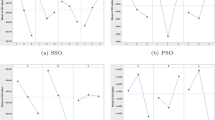Abstract
The primary objective of this paper is to study a two-machine flowshop scheduling problem with a learning effect where the goal is to find a sequence that minimizes the maximum tardiness. We employ a branch-and-bound method and a simulated annealing (SA) method to search for the optimal solution and a near-optimal solution, respectively. Computational results, using Fisher’s (Math Program 11:229–251 1971) framework, show that the mean and maximum number of nodes for the branch-and-bound algorithm decrease when the learning effect is stronger, the value of the tardiness factor is smaller, or the value of the due date range is larger. In addition, comparisons between the SA method and the earliest due date first (EDD) rule are provided for large-job sizes. Results indicate that the percentage of time that the SA solution outperforms the EDD solution decreases as the job size increases and the learning effect becomes greater. Additionally, the SA solution is never worse than the EDD solution.
Similar content being viewed by others
References
Biskup D (1999) Single-machine scheduling with learning considerations. Eur J Oper Res 115:173–178
Cheng TCE, Wang G (2000) Single machine scheduling with learning effect considerations. Ann Oper Res 98:273–290
Dileepan P, Sen T (1988) Bicriterion static scheduling research for a single machine. Omega 16:53–59
Dondeti VR, Mohanty BB (1998) Impact of learning and fatigue factors on single machine scheduling with penalties for tardy jobs. Eur J Oper Res 105:509–524
Fisher ML (1971) A dual algorithm for the one-machine scheduling problem. Math Program 11:229–251
Gawiejnowicz S (1996) A note on scheduling on a single processor with speed dependent on a number of executed jobs. Inf Process Lett 56:297–300
Heiser J, Render B (1999) Operations management. Prentice Hall, Englewood Cliffs, NJ
Kirkpatrick S, Gellat CD, Vecchi MP (1983) Optimization by simulated annealing algorithm. Science 220:671–680
Koulamas C, Antony SR, Jean R (1994) A survey of simulated annealing applications to operations research problems. Omega 22:41–56
Lee WC, Wu CC (2004) Minimizing total completion time in a two-machine flowshop with a learning effect. Int J Prod Econ 88:85–93
Lee WC, Wu CC, Sung HJ (2004) A bi-criterion single-machine scheduling problem with learning considerations. Acta Informatica 40:303–315
Lenstra JK, Rinnooy AHG, Brucker P (1977) Complexity of machine scheduling problems. Annal Dis Math 1:1016-1019
Meilijson I, Tamir A (1984) Minimizing flow time on parallel identical processors with variable unit processing time. Oper Res 32:440–448
Mosheiov G (2001a) Scheduling problems with a learning effect. Eur J Oper Res 132:687–693
Mosheiov G (2001b) Parallel machine scheduling with a learning effect. J Oper Res Soc 52:1165–1169
Mosheiov G, Sidney J (2003) Scheduling with general job-dependent learning curves. Eur J Oper Res 147:665–670
Nagar A, Haddack J, Heragu S (1995) Multiple and bicriteria scheduling: a literature survey. Eur J Oper Res 81:88–104
Russell R, Taylor BW III (2000) Operations management: multimedia version. Prentice Hall, Englewood Cliffs, NJ
Wright TP (1936) Factors affecting the cost of airplanes. J Aeronaut Sci 3:122–128
Yelle LE (1979) The learning curve: historical review and comprehensive survey. Decis Sci 10:302–328
Author information
Authors and Affiliations
Corresponding author
Rights and permissions
About this article
Cite this article
Wu, CC., Lee, WC. & Wang, WC. A two-machine flowshop maximum tardiness scheduling problem with a learning effect. Int J Adv Manuf Technol 31, 743–750 (2007). https://doi.org/10.1007/s00170-005-0255-y
Received:
Accepted:
Published:
Issue Date:
DOI: https://doi.org/10.1007/s00170-005-0255-y




